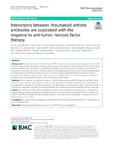Mostrar el registro sencillo del ítem
Interactions between rheumatoid arthritis antibodies are associated with the response to anti-tumor necrosis factor therapy
| dc.contributor.author | Juliá, Antonio | |
| dc.contributor.author | López-Lasanta, María | |
| dc.contributor.author | Blanco García, Francisco J | |
| dc.contributor.author | Gómez, Antonio | |
| dc.contributor.author | Haro, Isabel | |
| dc.contributor.author | juan Más, Antonio | |
| dc.contributor.author | Erra, Alba | |
| dc.contributor.author | García-Vivar, María L. | |
| dc.contributor.author | Monfort, Jordi | |
| dc.contributor.author | Sánchez-Fernández, Simón | |
| dc.contributor.author | González, Isidoro | |
| dc.contributor.author | Alperi-López, Mercedes | |
| dc.contributor.author | Castellanos-Moreira, Raúl | |
| dc.contributor.author | Fernández-Nebro, Antonio | |
| dc.contributor.author | Díaz-Torné, César | |
| dc.contributor.author | Lastra, Raquel M. | |
| dc.contributor.author | Lladós, Jordi | |
| dc.contributor.author | Palau, Núria | |
| dc.contributor.author | Sanmartí, Raimon | |
| dc.contributor.author | Marsal, Sara | |
| dc.date.accessioned | 2021-05-07T07:28:39Z | |
| dc.date.available | 2021-05-07T07:28:39Z | |
| dc.date.issued | 2021-04-21 | |
| dc.identifier.citation | Julià A, López-Lasanta M, Blanco F, Gómez A, Haro I, Mas AJ, Erra A, Vivar MLG, Monfort J, Sánchez-Fernández S, González I, Alperi M, Castellanos-Moreira R, Fernández-Nebro A, Díaz-Torné C, Palau N, Lastra R, Lladós J, Sanmartí R, Marsal S. Interactions between rheumatoid arthritis antibodies are associated with the response to anti-tumor necrosis factor therapy. BMC Musculoskelet Disord. 2021 Apr 21;22(1):372. | es_ES |
| dc.identifier.issn | 1471-2474 | |
| dc.identifier.uri | http://hdl.handle.net/2183/27901 | |
| dc.description.abstract | [Abstract] Background. Blocking of the Tumor Necrosis Factor (TNF) activity is a successful therapeutic approach for 50–60% of rheumatoid arthritis (RA) patients. However, there are yet no biomarkers to stratify patients for anti-TNF therapy. Rheumatoid factor (RF) and anti-cyclic-citrullinated antibodies (anti-CCP) have been evaluated as biomarkers of response but the results have shown limited consistency. Anti-carbamylated protein (anti-CarP) and anti-peptidylarginine deiminase type 4 (anti-PAD4) antibodies have been much less studied. Despite being linked to common immune processes, the interaction between these markers has not been evaluated yet. Our aim was to analyze the interaction between these four antibodies in relation to the response to anti-TNF therapy. Methods. For this objective, a prospective cohort of n = 80 RA patients starting anti-TNF therapy was recruited. Serum determinations at baseline were performed for RF, anti-CCP, anti-CarP and anti-PAD4 antibodies using enzyme-linked immunosorbent assays (ELISA). The clinical response to anti-TNF therapy was determined at week 12 using the change in DAS28 score. Association was performed using multivariate linear regression adjusting for baseline DAS28, sex and age. Results. The interaction between pairs of antibodies was tested by the addition of an interaction term. We found two highly significant antibody interactions associated with treatment response: anti-CarP with anti-PAD4 (p = 0.0062), and anti-CCP with RF (p = 0.00068). The latter antibody interaction was replicated in an independent retrospective cohort of RA patients (n = 199, p = 0.04). Conclusions. The results of this study suggest that antibody interaction effects are important factors in the response to anti-TNF therapy in RA. | es_ES |
| dc.language.iso | eng | es_ES |
| dc.publisher | Springer | es_ES |
| dc.relation.uri | https://dx.doi.org/10.1186%2Fs12891-021-04248-y | es_ES |
| dc.rights | Creative Commons Attribution 4.0 International License (CC-BY 4.0) | es_ES |
| dc.rights.uri | http://creativecommons.org/licenses/by/4.0/ | * |
| dc.subject | Rheumatoid arthritis | es_ES |
| dc.subject | Treatment response | es_ES |
| dc.subject | Anti-TNF therapy | es_ES |
| dc.subject | Autoantibodies | es_ES |
| dc.title | Interactions between rheumatoid arthritis antibodies are associated with the response to anti-tumor necrosis factor therapy | es_ES |
| dc.type | info:eu-repo/semantics/article | es_ES |
| dc.rights.access | info:eu-repo/semantics/openAccess | es_ES |
| UDC.journalTitle | BMC Muskuloskeletal Disorders | es_ES |
| UDC.volume | 22 | es_ES |
| UDC.startPage | 372 | es_ES |
Ficheros en el ítem
Este ítem aparece en la(s) siguiente(s) colección(ones)
-
INIBIC- REUMA - Artigos [184]







